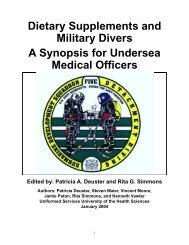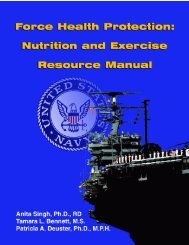Traumatic Brain Injury and Effects of Altitude - Human Performance ...
Traumatic Brain Injury and Effects of Altitude - Human Performance ...
Traumatic Brain Injury and Effects of Altitude - Human Performance ...
Create successful ePaper yourself
Turn your PDF publications into a flip-book with our unique Google optimized e-Paper software.
<strong>Traumatic</strong> <strong>Brain</strong> <strong>Injury</strong> (TBI) <strong>and</strong> <strong>Effects</strong> <strong>of</strong> <strong>Altitude</strong>:An Analysis <strong>of</strong> the Literature123. Patel, HC, Menon, DK, Tebbs, S, et al. (2002). Specialist neurocritical care <strong>and</strong> outcome from headinjury. Intensive Care Med, 28, 547-553.124. Polderman, K, Peerdeman, S, et al. (2002). <strong>Effects</strong> <strong>of</strong> therapeutic hypothermia on intracranialpressure <strong>and</strong> outcome in patients with severe head injury. Intensive Care Med, 28, 1563-1573.125. Poste, JC, Davis, DP, Hoyt, DB, et al. (2004). Aeromedical transport <strong>of</strong> severely head-injuredpatients undergoing paramedic rapid sequence intubation. Air Med J, 23, 36-40.126. Povlishock, J.T., Erb, D.E., & Astruc, J. (1992). Axonal response to traumatic brain injury: reactiveaxonal change, deafferentation, <strong>and</strong> neuroplasticity. J Neurotrauma, 9, S189-S200.127. Raghupathi, R., Conti, A.C., Graham, D.I., et al. (2002). Mild traumatic brain injury inducesapoptotic cell death in the cortex that is preceded by decreases in cellular Bcl-2 immunoreactivity.Neuroscience, 110, 605-616.128. Rangel-Castillo, L, Gopinath, S, & Robertson, CS (2008). Management <strong>of</strong> intracranial hypertension.Neurol Clin, 26, 521-541.129. Reddick, EJ (1977). Aeromedical evacuation. American Family Physician, 16, 154-160.130. Regard, M, Oelz, O, Brugger, P, & L<strong>and</strong>is, T (1989). Persistent cognitive impairment in climbersafter repeated exposure to extreme altitude. Neurology, 39, 210-213.131. Rhind, SG, Crnko, NT, Baker, AJ, et al. (2010). Prehospital resuscitation with hypertonic salinedextranmodulates inflammatory, coagulation <strong>and</strong> endothelial activation marker pr<strong>of</strong>iles in severetraumatic brain injured patients. J Neuroinflammation, 7, 5-21.132. Roach, RC & Hackett, PH (2001). Frontiers <strong>of</strong> hypoxia research: acute mountain sickness. J Exp Biol,204, 3161-3170.133. Rosner MJ, Rosner SD, & Johnson AH (1995). Cerebral perfusion pressure management protocol<strong>and</strong> clinical results. J Neurosurg, 83, 949-962.134. Rudehill, A, Bell<strong>and</strong>er, BM, Weitzberg, E, et al. (2002). Outcome <strong>of</strong> traumatic brain injuries in 1,508 patients: impact <strong>of</strong> prehospital care. J Neurotrauma, 19, 855-868.135. S<strong>and</strong>hu, K, Murthy, TVSP, Prabhakar, T (2004). Hypertonic saline in traumatic brain injury: currentstatus. Indian J Neurotrauma, 1, 15-20.136. Sauaia, A, Moore, FA, Moore, EE, et al. (1995). Epidemiology <strong>of</strong> trauma deaths: a reassessment. JTrauma, 38, 185-193.137. Schmidt, OI, Heyde, CE, Ertel, W, & Stahel, PF (2005). Closed head injury – an inflammatorydisease? <strong>Brain</strong> Research Reviews, 48, 388-399.138. Schmoker, JD, Zhuang, J, & Shackford, SR (1991). Hypertonic fluid resuscitation improves cerebraloxygen delivery <strong>and</strong> reduces intracranial pressure after hemorrhagic shock. J Trauma, 31, 1607-1613.139. Schoene, RB (2005). Dexamethasone: by safe means, by fair means. High <strong>Altitude</strong> Medicine &Biology, 6, 273-275.140. Schreiber, MA, Aoki, N, Scott, BG, et al. (2002). Determinants <strong>of</strong> mortality in patients with severeblunt head injury. Arch Surg, 137, 285-290.September 14, 2010 35


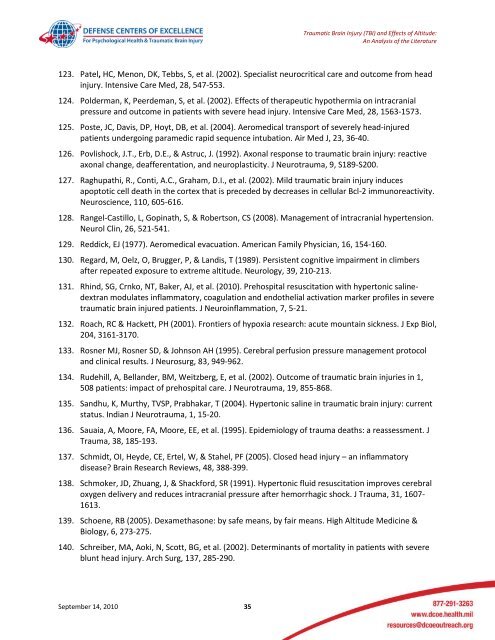
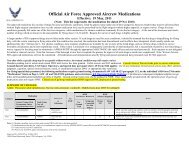
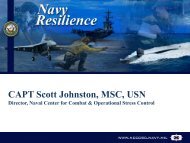
![Body Composition and Military [PDF] - Human Performance ...](https://img.yumpu.com/43269347/1/190x245/body-composition-and-military-pdf-human-performance-.jpg?quality=85)
![Tips for Grocery Shopping [PDF]](https://img.yumpu.com/37447379/1/190x245/tips-for-grocery-shopping-pdf.jpg?quality=85)
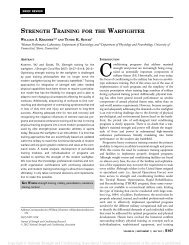
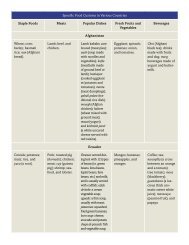
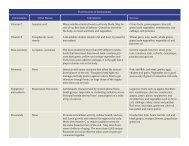
![Synthetic Drugs [PDF] - Human Performance Resource Center](https://img.yumpu.com/37447322/1/190x245/synthetic-drugs-pdf-human-performance-resource-center.jpg?quality=85)
